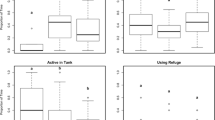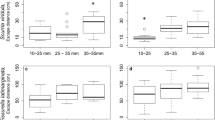Abstract
The duration of cirral withdrawal in Balanus glandula (Darwin) varies by a factor of three depending on the type of stimulus applied. Contact with potential predators including thaidid gastropods (Thais emarginata, T. lamellosa), and forcipulate asteroids (Leptasterias hexactis, Pycnopodia helianthoides) elicits significantly longer withdrawal durations than contact with an herbivorous gastropod (Tegula pulligo), a grazing, spinulosid asteroid (Henricia leviuscula) or a neutral, brown algal stimulus (Fucus distichus). By substantially attenuating the release of metabolites, prolonged withdrawal probably increases the likelihood of being bypassed by nonvisual predators relying on chemical cues to verify that barnacles are alive. The reduced response to the non-predatory species indicates that this is not a generalized response to gastropods or asteroids, but rather that it appears to be specific to potential predatory species.
Similar content being viewed by others
Literature cited
Ansell, A. D.: Defensive adaptations to predation in the Mollusca. Proc. Symp. on Mollusca 2, 487–512 (1969)
Barnett, B. E.: A laboratory study of predation by the dog-whelk Nucella lapillus on the barnacles Elminius modestus and Balanus balanoides. J. mar. Biol. Ass. UK 59, 299–306 (1979)
Blake, J. W.: Oxygen consumption of bivalve prey and their attractiveness to the gastropod Urosalpinx cinerea. Limnol. Oceanogr. 5, 273–280 (1960)
Bloom, S. A.: The motile escape response of a sessile prey: a sponge-scallop mutualism. J. exp. mar. Biol. Ecol. 17, 311–321 (1975)
Bullock, T. H.: Predator recognition and escape responses of some intertidal gastropods in the presence of starfish. Behav. 5, 130–140 (1953)
Carefoot, T. H.: Pacific Seashores, 208 pp. Seattle: Univ. Wash. Press 1977
Carriker, M. R. and D. van Zandt: Predatory behavior of a shell boring muricid gastropod. In: Behavior of marine animals, Vol. 1: Invertebrates, pp 157–244. Ed. by H. E. Winn and B. L. Olla. New York: Plenum Press 1972
Castilla, J. C.: Responses of Asterias rubens to bivalve prey in a Y-maze. Mar. Biol. 12, 222–228 (1972)
Castilla, J. C. and D. J. Crisp: Responses of Asterias rubens to olfactory stimuli. J. mar. Biol. Ass. UK 50, 829–847 (1970)
Connell, J. H.: A predator prey system in the marine intertidal region. I Balanus glandula and several predatory species of Thais. Ecol. Monogr. 40, 49–78 (1970)
Dayton, P. K.: Competition, disturbance and community organization: provision and subsequent utilization of space in a rocky intertidal community. Ecol. Monogr. 41, 351–389 (1971)
Emlen, J. M.: Time energy and risk in two species of carnivorous gastropods, 28 pp. PhD dissertation, Seattle: University of Washington 1966
Feder, H. M.: Escape responses in marine invertebrates. Sci. Amer. 227, 92–100 (1972)
Feder, H. M. and R. Lasker: Partial purification of a substance from starfish tube feet which elicits escape responses in gastropod molluscs. Life Sci. 3, 1047–1051 (1964)
Forester, A. J.: The association between the sponge Halichondria panicea (Pallas) and scallop Chlamys varia (L): a commensal-protective mutualism. J. exp. mar. Biol. Ecol. 36, 1–10 (1979)
Foster, B. A. and J. A. Nott: Sensory structures in the opercula of the barnacle Elminius modestus. Mar. Biol. 4, 340–344 (1969)
Fishlyn, D. A. and J. A. Phillips: Chemical camouflaging and behavioral defenses against a predatory seastar by three species of gastropods from the surfgrass Phyllospadix community. Biol. Bull. mar. biol. Lab., Woods Hole 158, 34–48 (1980)
Gurin, S. and W. E. Carr: Chemoreception in Nassarius obsoletus: the role of specific stimulatory proteins. Science, N. Y. 174, 293–295 (1971)
Hoffman, D. L., W. C. Homan, J. Swanson and P. J. Weldon: Flight responses of three congeneric species of intertidal gastropods (Prosobranchia: Neritidae) to sympatric predatory gastropods from Barbados. Veliger 21, 293–296 (1978)
Kohn, A. J.: Chemoreception in gastropod molluscs. Am. Zool. 1, 291–308 (1961)
Mauzey, K. P., C. Birkeland and P. K. Dayton: The feeding behavior of asteroids and escape respones of their prey in the Puget Sound region. Ecology 49, 603–619 (1968)
Menge, B. A.: Foraging strategy of a starfish in relation to actual prey availability and environmental predictability. Ecol. Monogr. 42, 25–50 (1972)
Moitoza, D. J. and D. W. Phillips: Prey defense, predator preference and non-random diet: the interactions between Pycnopodia helianthoides and two species of sea urchins. Mar. Biol. 53, 299–304 (1979)
Morgan, P. R.: Nucella lapillus (L) as a predator of edible cockles. J. exp. mar. Biol. Ecol. 8, 45–53 (1972)
Palmer, A. R.: A comparative and experimental study of feeding and growth in thaidid gastropods, 320 pp. PhD. dissertation. Seattle: University of Washington 1980
Palmer, A. R.: Predation and parallel evolution: recurrent parietal plate reduction in balanomorph barnacles. Paleobiology 8(1), in press (1982)
Phillips, D. W.: Chemical mediation of invertebrate defensive behaviors and the ability to distinguish between foraging and inactive predators. Mar. Biol. 49, 237–243 (1978)
Pratt, D. M.: Attraction to prey and stimulus to attack in the predatory gastropod Urosalpinx cinerea. Mar. Biol. 27, 37–45 (1974)
Ricketts, E. F., J. Calvin and J. W. Hedgepeth: Between Pacific tides, 641 pp. Stanford: Stanford University Press 1968
Spight, T. M.: Sizes of populations of a marine snail. Ecology 55, 712–729 (1974)
Snyder, N. F. R. and H. A. Snyder: Pheromone-mediated behavior of Fasciolaria tulipa. Anim. Behav. 19, 257–268 (1971)
Steele, R. G. D. and J. H. Torrie: Principles and procedures in statistics, 418 pp. New York: McGraw-Hill 1960
Vermeij, G. J.: Biogeography and adaptation: patterns of marine life, 416 pp. Cambridge, Mass.: Harvard University Press 1978
Wood, L.: Physiological and ecological aspects of prey selection by the marine gastropod Urosalpinx cinerea (Prosobranchia: Muricidae). Malacologia 6, 267–320 (1968)
Author information
Authors and Affiliations
Additional information
Communicated by R. O. Fournier, Halifax
Rights and permissions
About this article
Cite this article
Palmer, A.R., Szymanska, J. & Thomas, L. Prolonged withdrawal: A possible predator evasion behavior in Balanus glandula (Crustacea: Cirripedia). Mar. Biol. 67, 51–55 (1982). https://doi.org/10.1007/BF00397094
Accepted:
Issue Date:
DOI: https://doi.org/10.1007/BF00397094




